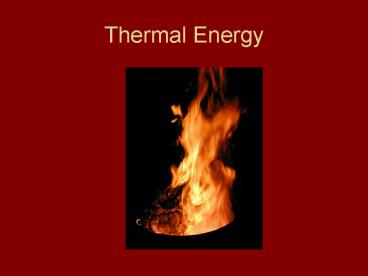Thermal Energy PowerPoint PPT Presentation
1 / 24
Title: Thermal Energy
1
Thermal Energy
2
Warm Up
- To shape metal into a horseshoe, the metal is
heated in a fire. Why will a horseshoe bend when
its very hot, but not after it cools?
3
What was different ?
- Matter is always in motion
- Particles of gases, liquids, and solids all
move
- There was more motion in the hot water
- The energy of motion is Kinetic Energy
4
Heat
- Heat is the transfer of thermal energy from one
object to another because of a temperature
difference. - Heat flows spontaneously from hot objects to cold
objects.
5
Heat
Heat is related to temperature The Temperature
of an object is the measurement of the average
kinetic energy (KE) of particles
6
- As an object heats up its particles move
__________________ on average. As a result, the
average kinetic energy (and the temperature)
_________________. - Number of collisions between particles
increases. Thermal energy is transferred from
hot to cold objects.
7
What do Temperature Scales Measure?
- Fahrenheit used in US
- Celsius used in other countries
- Kelvin SI unit
- 0 K -273C
- 0C 273 K
8
(No Transcript)
9
Thermal Energy
- Thermal Energy (Q) is the sum of the kinetic
energy the potential energy of all the
particles in an object - Thermal energy depends on the mass, temperature
and phase (solid, liquid, or gas) of an object.
Q KE PE
10
(No Transcript)
11
Thermodynamics
- First Law of Thermodynamics the increase in
thermal energy of a system equals the work done
on the system plus the heat transferred to the
system
- Energy is CONSERVED
12
Open Systems
- In an open system, heat flows across the
boundary, or work is done across the boundary. - What are examples of open systems?
13
Closed Systems
- In a closed system, no heat flows across the
boundary and no work is done across the boundary. - What are examples of closed systems?
14
Thermodynamics
- Second Law of Thermodynamics Heat flows from
warmer objects to cooler objects - Heat cannot flow from a cooler object to a
warmer object unless work is done
15
How do solids transfer heat?
- Conduction the transfer of thermal energy by
collisions between particles in matter. - Particles in solids vibrate and collide with each
other
- List 3 examples of conduction
16
Convection
- Convection is the transfer of thermal energy in a
gas or liquid by the movement of warmer and
cooler fluid from place to place.
- Knowing this, what will happen to a piece of ice
floating at the top of a warm glass of water? - What will happen to a piece of ice at the bottom
of a glass of water? - List 3 examples of convection
17
Radiation
- Radiation is the transfer of energy by
electromagnetic waves. These waves travel in the
empty spaces between particles until their energy
is absorbed by a particle. - Would radiation pass through a solid or a gas
more easily?
- List 3 examples of heat radiation.
18
(No Transcript)
19
(No Transcript)
20
Heat
- Heat is the thermal energy that is transferred
from particles at a higher temperature to
particles at a lower temperature
21
Can you control heat flow?
- An INSULATOR is a material in which heat flows
slowly - Good Insulators plastic, wood, air, fiberglass
- Materials that arent good insulators are
CONDUCTORS. Heat flows quickly through a
conductor. - Good Conductors
- metals
22
What if there is no material?
- There is no conduction if there is no matter. A
vacuum (empty space) is a perfect insulator
because very little heat transfer can take place.
- We use vacuum insulators and air insulators all
the time. List some examples.
23
How is the water inside being heated?
24
(No Transcript)

